Aerospace
Alaska Airlines one of first US Airlines to use virtual reality in pilot training
Alaska Airlines is one of the first US Airlines to use virtual reality in pilot training

The Flight Operations Training Center of Alaska Airlines now uses new technologies. Basic training for a pilot usually consists of classroom instruction, followed by half simulations, full simulations, and finally time in a real aircraft. Now, the first section of textbook training includes an introduction to virtual reality (VR).
The virtual reality goggles were utilised for the first time today by students like Scott Wathey, a newly hired First Officer with Alaska Airlines. Wathey compared it to how you know precisely where the snooze button is on your alarm clock in the morning. “This enables our muscle memory to remember exactly where that switch is,” said.
Pilots used flat posters that were taped to their walls to study before VR technology was available. The simulator’s lights and levers would require some getting used to. “We won’t need to waste four hours attempting to locate the switches when you begin your first simulator sessions. You can enter on day one and in the first minute and know precisely where things are “said Shawn Thumma, first officer for Alaska Airlines.
The technology has been in Alaska Airlines’ possession for almost a year, and it has been used for six months already. At a time when the airline is expanding its hiring procedure, this has happened. 300 Airbus pilots are currently learning to fly a Boeing 737 while 600 new pilots are being produced annually.
An essential action to assist in staffing airplanes and boost customer capacity. One of the first US airlines to deploy this VR technology is Alaska Airlines. They predict that because of its success, it will soon become the standard.

Aerospace
When Ratan Tata was denied entry to the airfield at the Aero India show, he waited

During our visit to Aero India 2019, we had the unexpected opportunity to see Ratan Tata at the event, which was a thrilling moment for us. However, there was a surprising hiccup when the security staff didn’t allow him to enter due to a lack of a security pass.
Despite this, he remained calm and patiently waited for about 20 minutes until a member of the Tata team brought him the required pass, after which he calmly proceeded inside. It was a humbling sight, showcasing his composed demeanor even in such situations.
Ratan Tata ji is not only a renowned industrialist but also a trained pilot, holding a pilot’s license. In 2007, he became the first Indian civilian to fly the F-16 Falcon during the Aero India show in Bangalore—a proud moment for the nation.
His passion for aviation extended beyond flying, as he played a key role in shaping India’s aerospace industry. Under his leadership, Tata ventured into manufacturing and maintaining aerospace components while upholding its legacy of quality. Notably, Tata’s collaboration with Airbus to develop and manufacture the C295 aircraft is a testament to its growing influence in the sector.
-

 Aviation2 months ago
Aviation2 months agoMicrosoft Flight Simulator Raises $3 Million to Bring Back the An-225 Mriya
-

 Airlines2 months ago
Airlines2 months agoQantas Engineers Stage Walkout Over Cost of Living Concerns
-

 Airlines2 months ago
Airlines2 months agoQatar Citizens Can Travel to the United States Without a Visa
-

 Aviation2 months ago
Aviation2 months agoQatar Airways bans these new Electronic Devices on plane
-

 Airlines2 months ago
Airlines2 months agoJapan Airlines Rolls Out Free Domestic Flights to International Passengers
-

 Defence2 months ago
Defence2 months agoWhich Country Has the Largest Fleet of Fighter Aircraft?
-

 Airport2 months ago
Airport2 months agoWestern Sydney Airport Welcomes Its First Plane After 6 Years of construction
-

 Aviation2 months ago
Aviation2 months agoDid you know ? Once Boeing 747 carried 1088 passenger in 1991








